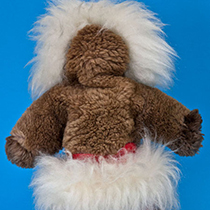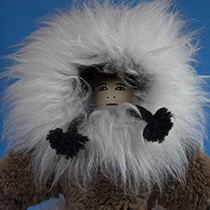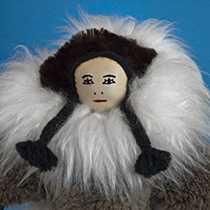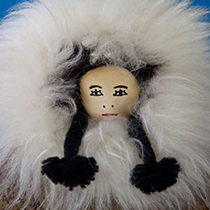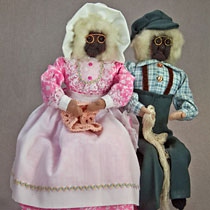Description of Figure/Doll
Handmade Inuit doll from Nunavut, Canada. In 1999, Nunavut separated from the Northwest Territories to become a Canadian territory. Nunavut was the outcome of aboriginal land claims agreement between the Canadian government and the native Inuit people (which make up 83% of the population). This doll is made with real fur and leather. She is wearing a fur parka with white fur around the face. Her hair is braided yarn, and her facial features are painted on leather. She has small, colorful beads sewn around the waist area and the top of the boots. Her boots are also made from fur and leather.
Link to higher resolution images at ClipPix
Canada: Nunavut
Location: Northern Canada
Capital: Iquluit
Main language: English, French
Currency: Canadian dollar
Figure/Doll
Construction: fur, leather
Height in Centimeters: 33
Height in Inches: 13


Living in Nunavut: Cold, Dark, Treeless Wonderland in Northern Canada
Reading Level: 6.30
My name is Margaret, and I am a Canadian. My family lived in Toronto until recently. Two years ago, my mother accepted a teaching job in the Nunavut territory. The Nunavut territory is the far northern part of Canada.
We moved to the Iqaluit, the capital city of Nunavut. It’s really a small town. All we have to do is walk a few blocks to go anywhere. Like other towns up here, the only way in or out is by airplane or boat. In fact, before winter sets in, we have to make sure we have enough food until spring. Food prices are higher here than in other parts of Canada because it costs so much to ship the supplies.
The weather in the Nunavut is extremely cold. It’s called a polar climate, and, yes, there are polar bears here! The temperature can go down to many, many degrees below zero. When that happens, we have to really bundle up to go outside. We wear fur coats, masks, googles, boots, polar mitts, etc.
Most of the people who live here are Inuits. They are natives from the Arctic regions of Greenland, Alaska, and northern Canada. Many of the Inuit people hunt and fish for a living, just like their ancestors did. They hunt whales, bears, seal, caribou and other animals.
Living in Nunavut has its drawbacks. For example, there is very little daylight in the winter months. However, in the summer, there is daylight all day and almost all night. That means we can go boating, camping, and hiking for many hours. It took me awhile to get used to the fact that there are no trees here. Apparently, Nunavut is considered part of the Arctic tundra because it is above the tree line.
My best friend is Sedna. Her name means Goddess of the Deep Sea in Inuktitut, the official language. Sometimes Sedna’s father lets us go out in the boat with him when he’s fishing. One time, we even saw the sky light up with the Northern Lights! My life is definitely different here than it was in Toronto. However, I am really enjoying the new adventures and friends.


